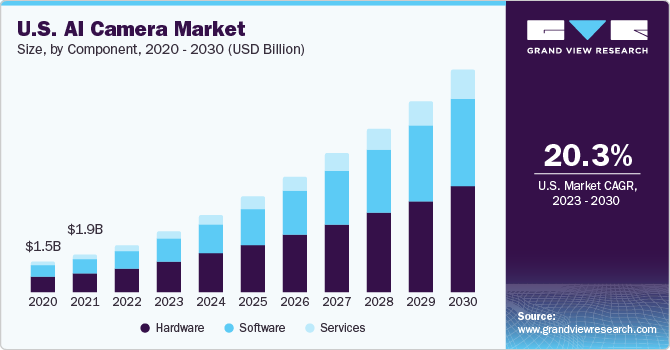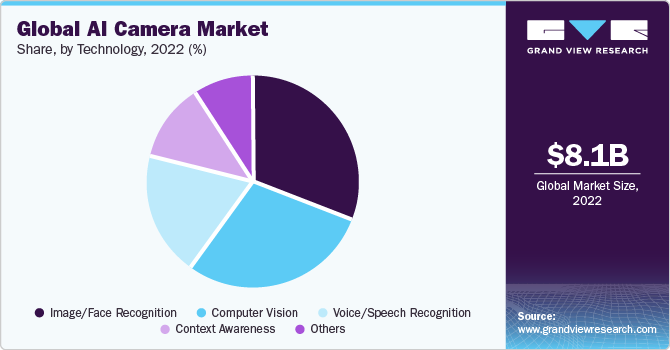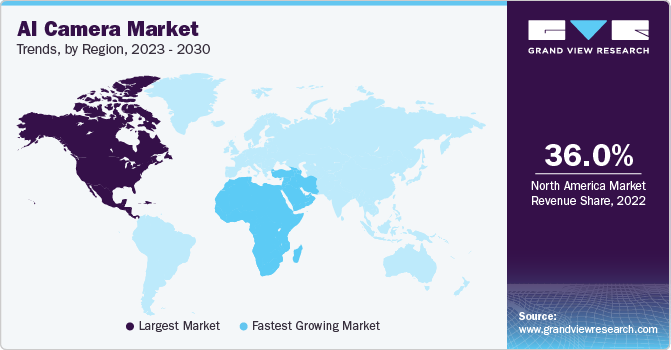- Home
- »
- Next Generation Technologies
- »
-
AI Camera Market Size, Share, Growth, Trends Report, 2030GVR Report cover
![AI Camera Market Size, Share & Trends Report]()
AI Camera Market Size, Share & Trends Analysis Report By Component (Hardware, Software, Services), By Type, By Technology, By Industry Vertical, By Region, And Segment Forecasts, 2023 - 2030
- Report ID: GVR-4-68040-135-8
- Number of Report Pages: 140
- Format: PDF, Horizon Databook
- Historical Range: 2018 - 2021
- Forecast Period: 2023 - 2030
- Industry: Technology
AI Camera Market Size & Trends
The global AI camera market size was estimated at USD 8.09 billion in 2022 and is expected to grow at a compound annual growth rate (CAGR) of 23.1% from 2023 to 2030. The growth can be credited to the growing consumer inclination toward technologically advanced devices based on the latest technologies such as Artificial Intelligence (AI) and Machine Learning (ML). As a result, AI-based cameras are gaining massive traction not only across photography and videography domains but across several other verticals, such as government and law enforcement, consumer electronics, sports, agriculture, automotive, healthcare, manufacturing, etc. The increasing product demand in various industries is driving the expansion of the market.

An AI camera can recognize and process visual information within a scene by using computer vision, machine learning algorithms, and other AI techniques, thereby enabling scene recognition, object recognition, image enhancement, facial recognition, smart composition, video stabilization, etc. Several companies operating within the AI camera market are strongly focusing on the development of these smart devices to cater to their rising demand. In August 2023, Google LLC announced the launch of Pixel 8 and Pixel 8 Pro smartphones during an official Made by Google event to be held in October 2023 in New York, U.S. These smartphones will be equipped with AI cameras capable of recording night sight video in low light and detecting unwanted audio in captured videos using an audio eraser.
Component Insights
The hardware segment captured a revenue share of around 54.0% in 2022 and is estimated to record significant growth over the coming years. The camera hardware is crucial for determining its capabilities, performance, and overall user experience. For instance, AI cameras require high processing power to run complex computer vision algorithms, which necessitates powerful hardware components, especially the graphics processing units and the central processing unit. Other hardware products that support the advanced functionalities of an AI camera include image sensors, storage units, connectivity options, such as Wi-Fi and Bluetooth, battery with longer life, solutions for thermal management, etc.
The software segment is estimated to record a CAGR of over 24.0% from 2023 to 2030. The camera software is significant for enhancing, compositing, and transforming photographs and videos to professional grade. The software comes with various features and shooting modes. It is responsible for integrating complex AI algorithms that enable intelligent features, such as scene recognition, facial recognition, object tracking, and image enhancement. Moreover, they also facilitate the processing of images in real time, enabling instantaneous scene recognition, exposure, and autofocus adjustments.
Type Insights
The surveillance cameras segment captured a revenue share of around 32.0% in 2022. The growing urban population has created a high demand for continuous surveillance to ensure the safety of the citizens. Moreover, businesses are also investing in AI-based surveillance cameras to ensure 24/7 security for their infrastructure and the overall premises. The AI cameras capture images and videos for creating security protocols with the help of facial recognition to monitor and analyze crowds and process videos in real time to identify threats. These cameras are specialized to perform advanced analytical functions, including vehicle detection, person detection, face detection, traffic counting, people counting, and license plate recognition.
The digital cameras segment is estimated to record a CAGR of over 21.0% from 2023 to 2030 with the increasing prominence of enhanced images and videos in the photography domain. AI cameras automatically detect the subject and then optimize the photos according to specific scenarios. They can also adjust other parameters automatically that are usually known to the professional photographer, such as ISO, High Dynamic Range (HDR), white balance, manual focusing, etc. In this regard, AI technology eliminates the need to learn these functionalities for users who are unaware of these parameters or not involved in photography professionally.
Industry Vertical Insights
The consumer electronics segment captured a revenue share of around 20.0% in 2022 and is estimated to record significant growth over the coming years. AI cameras are transforming the outlook of the consumer electronics industry by changing the way images and videos are captured and interacted with. They find important applications in smartphones and various high-end cameras used in photography. These cameras offer features such as scene recognition, which automatically detects the subject and accordingly adjusts settings, resulting in well-balanced and better-exposed photos. AI cameras can also apply real-time effects and filters to images and videos, providing users with creative options to capture unique and visually appealing content.
Technology Insights
The image/face recognition segment captured a revenue share of around 31.0% in 2022. Face or image recognition technology is a popular AI-based feature of these cameras. It allows the camera to focus on faces, improving the quality of portraits and group photos. Some AI cameras are equipped to detect and prioritize a particular facial expression, ensuring everyone looks their best in the shot. This feature has now evolved to distinguish subjects from backgrounds and create portrait mode, which is a simulated shallow depth of field effect in images. Facial recognition finds crucial applications in surveillance cameras and also enables face unlock in smartphones.

The computer vision segment is estimated to record a CAGR of nearly 24.0% from 2023 to 2030 with the increasing adoption of this technology. It allows computers and systems to obtain meaningful information from videos, digital images, and other visual inputs, and make recommendations or take actions according to that information. The AI camera views an image while the computer vision algorithms interpret and process the image, before instructing other components to act upon that data. Facial recognition utilizes computer vision to identify people in videos and photos, which in turn is used to tag people on social media platforms and by law enforcement agencies to track suspicious individuals.
Regional Insights
North America captured a revenue share of nearly 36.0% of the AI camera market in 2022. This can be attributed to the greater consumer inclination toward smart devices and technologically advanced solutions in the region. Moreover, the strong presence of various major technology companies and AI camera manufacturers in the region is also creating a positive outlook for the regional market. Besides, supportive government initiatives to integrate AI in various federal systems and law enforcement efforts are also creating growth opportunities for the market. In 2021, the U.S. government announced its plans to employ facial recognition systems among several federal agencies. As a result, 10 of the 24 agencies surveyed by the government made plans to expand their technology usage by 2023, while some of the agencies are also making significant investments in research and development.

Middle East & Africa is expected to record a CAGR of over 26.0% from 2023 to 2030 with the growing interest of consumers in technologically advanced devices coupled with the expansion of several major consumer electronics companies in the region. The availability of leading brands in the electronics segment and rising disposable incomes are impelling product adoption further.In addition, increasing government initiatives to leverage AI-based systems in surveillance and law enforcement initiatives is expected to open new growth avenues for the regional market. For instance, the government authorities in Dubai have installed thousands of AI-based CCTV cameras in the city which send live images of security breaches to the Central Command Centre.
Key Companies & Market Share Insights
The key players are actively involved in strategic initiatives, such as mergers and acquisitions, collaborations, partnerships, and new product launches to strengthen their presence in the industry. In March 2023, Teledyne FLIR LLC expanded its broad portfolio of visible cameras with the addition of Quasar Premium Mini-Dome AI, a range of AI-based visible security cameras. These cameras are equipped with 12 unique analytics for detecting vehicles, people, objects, events, and attributes. It is fully NDAA-compliant and uses advanced cybersecurity safeguards. Moreover, the FLIR Quasar Premium Mini-Dome AI camera also provides easy integration with various video management systems, delivering an end-to-end cost-effective solution for surveillance. Some prominent players in the global AI camera market include:
-
AV Costar
-
Axis Communications AB
-
Bosch Sicherheitssysteme GmbH
-
Canon Inc.
-
Hangzhou Hikvision Digital Technology Co., Ltd.
-
Honeywell International Inc.
-
Huawei Technologies Co., Ltd.
-
Johnson Controls
-
LG Electronics
-
Nikon Corporation
-
Panasonic Holdings Corporation
-
Samsung Electronics Co., Ltd.
-
Sony Corporation
-
Teledyne FLIR LLC
AI Camera Market Report Scope
Report Attribute
Details
Market size value in 2023
USD 10.77 billion
Revenue forecast in 2030
USD 46.06 billion
Growth rate
CAGR of 23.1% from 2023 to 2030
Base year for estimation
2022
Historical data
2018 - 2021
Forecast period
2023 - 2030
Quantitative units
Revenue in USD million/billion and CAGR from 2023 to 2030
Report coverage
Revenue forecast, company ranking, competitive landscape, growth factors, and trends
Segments covered
Component, type, technology, industry vertical, region
Regional Scope
North America; Europe; Asia Pacific; Latin America; Middle East & Africa
Country Scope
U.S.; Canada; UK; Germany; France; Spain; Italy; China; India; Japan; Australia; South Korea; Brazil; Mexico; Saudi Arabia; South Africa
Key companies profiled
Canon Inc.; Bosch Sicherheitssysteme GmbH; Honeywell International Inc.; Sony Corporation; Hangzhou Hikvision Digital Technology Co., Ltd.; Teledyne FLIR LLC; Huawei Technologies Co., Ltd.; Panasonic Holdings Corporation; Nikon Corporation; Johnson Controls; AV Costar; Samsung Electronics Co., Ltd.; LG Electronics; Axis Communications AB
Pricing and purchase options
Free re Free report customization (equivalent to 8 analyst working days) with purchase. Addition or alteration to country, regional & segment scope.
Pricing and purchase options
Avail customized purchase options to meet your exact research needs. Explore purchase options Global AI Camera Market Market Report Segmentation
This report forecasts revenue growth at the global level and provides an analysis of the latest industry trends in each of the sub-segments from 2018 to 2030. For this study, Grand View Research has segmented the global AI camera market report based on component, type, technology, industry vertical, and region:
-
Component Outlook (Revenue, USD Million, 2018 - 2030)
-
Hardware
-
Software
-
Services
-
-
Type Outlook (Revenue, USD Million, 2018 - 2030)
-
Surveillance Cameras
-
Smartphone Cameras
-
Digital Cameras
-
Industrial Cameras
-
Others
-
-
Technology Outlook (Revenue, USD Million, 2018 - 2030)
-
Image/Face Recognition
-
Voice/Speech Recognition
-
Computer Vision
-
Context Awareness
-
Others
-
-
Industry Vertical Outlook (Revenue, USD Million, 2018 - 2030)
-
Consumer Electronics
-
Manufacturing
-
Sports
-
Agriculture
-
Retail
-
Healthcare
-
Transportation
-
Government & Law Enforcement
-
Automotive
-
Others
-
-
Regional Outlook (Revenue, USD Million, 2018 - 2030)
-
North America
-
U.S.
-
Canada
-
-
Europe
-
UK
-
Germany
-
France
-
Italy
-
Spain
-
-
Asia Pacific
-
China
-
Japan
-
India
-
Australia
-
South Korea
-
-
Latin America
-
Mexico
-
Brazil
-
-
Middle East & Africa (MEA)
-
Saudi Arabia
-
South Africa
-
-
Frequently Asked Questions About This Report
b. The AI camera market size was estimated at USD 8.09 billion in 2022 and is expected to reach USD 10.77 billion in 2023.
b. The AI camera market is expected to grow at a compound annual growth rate of 23.1% from 2023 to 2030 to reach USD 46.06 billion by 2030.
b. North America region dominated the AI camera market with a share of nearly 36.0% in 2022. This can be attributed to the greater consumer inclination toward smart devices and technologically advanced solutions in the region. Moreover, the strong presence of various major technology companies and AI camera manufacturers in the region is also creating a positive outlook for the regional market.
b. Some key players operating in the AI camera market include Axis Communications AB, Bosch Sicherheitssysteme GmbH, Canon Inc., Honeywell International Inc., Huawei Technologies Co., Ltd., and many others.
b. The market's growth can be credited to the growing consumer inclination toward technologically advanced devices based on the latest technologies such as Artificial Intelligence (AI) and Machine Learning (ML). As a result, AI-based cameras are gaining massive traction not only across photography and videography domains but across several other verticals, such as government and law enforcement, consumer electronics, sports, agriculture, automotive, healthcare, manufacturing, etc.
Share this report with your colleague or friend.
![gvr icn]()
NEED A CUSTOM REPORT?
We can customize every report - free of charge - including purchasing stand-alone sections or country-level reports, as well as offer affordable discounts for start-ups & universities. Contact us now
![Certified Icon]()
We are GDPR and CCPA compliant! Your transaction & personal information is safe and secure. For more details, please read our privacy policy.
We are committed towards customer satisfaction, and quality service.
"The quality of research they have done for us has been excellent."





